La problemática urbana del Risco de San Juan: análisis y propuestas
Keywords:
crecimiento marginal, morfología urbana, trazado viario, mobiliario urbano, mejoras urbanas, marginal growth, urban morphology, road network, urban fixtures and improvementsAbstract
En este artículo se aborda el estudio de un sector urbano antiguo de la ciudad de Las Palmas de Gran Canaria que surge en el siglo XVII como un espacio marginal localizado en las laderas que rodeaban el centro histórico, y que todavía hoy se ve afectado de numerosos problemas sociales y urbanos. La metodología utilizada se basa en el análisis de diferentes variables urbanas a través de las cuales podremos descifrar las claves de ocupación de este barrio y, en función de los resultados, buscar soluciones prácticas centradas en reformas, adaptaciones y aprovechamientos de elementos existentes. Con ello se pretende mejorar la calidad de vida de sus habitantes, y ayudar a que el barrio recobre su lugar dentro del conjunto urbano y salir del olvido y marginación.
This article is about the study of an old urban sector of the city of Las Palmas de Gran Canaria, that arises in the XVII century as a marginal space located on the slopes that surrounded the historical center, and which still today is affected by many social and urban problems. The methodology used is based on the analysis of different urban variables through which we can discover key facts about occupation in this sector, and as a function of those findings, look for practical solutions through reforms, adaptations and the use of existing elements. All of these are intended to improve the quality of life of its inhabitants, and help the neighborhood regain its place within the urban area, as well as to get out of oblivion and marginalization.
Downloads
Downloads
Issue
Section
License
The articles are open access distributed under the terms of the Creative Commons Attribution-NonCommercial-NoDerivatives (CC BY-NC-ND) Spain 4.0 license. Authors who publish in this journal agree with the following terms:
a) Authors retain the copyright and guarantee the journal the right to be the first publication of the work as well as licensed under a Creative Commons Attribution License that allows others to share the work with a recognition of the authorship of the work and the Initial publication in this magazine.
b) Authors may separately establish additional agreements for the non-exclusive distribution of the version of the work published in the journal (for example, place it in an institutional repository or publish it in a book), with recognition of its initial publication in this magazine.
c) Authors are allowed and encouraged to disseminate their work electronically (for example, in institutional repositories or on their own website) before and during the submission process, as it may result in productive exchanges, as well as a earliest and largest citation of published works (See The Effect of Open Access).



